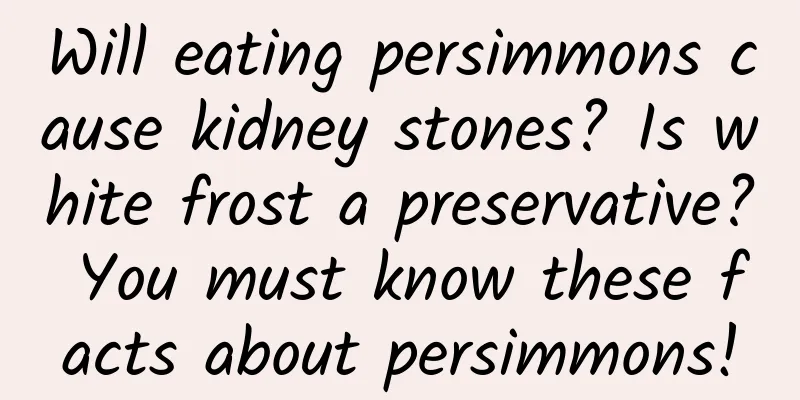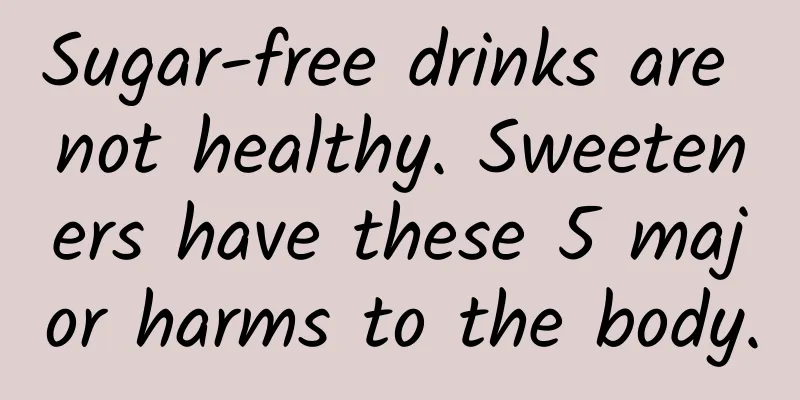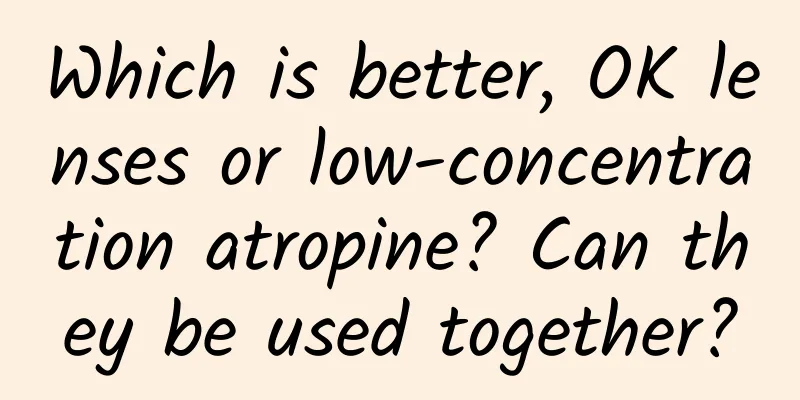Will eating persimmons cause kidney stones? Is white frost a preservative? You must know these facts about persimmons!

|
Recently, it is the season for persimmons. Persimmons are auspicious fruits in autumn. People have always placed great expectations on them, hoping that eating them will make their wishes come true, and that their wishes will come true. However, there are many controversies about eating persimmons. Some people praise it for being delicious and nutritious, while others say it is unpalatable and harmful to health. What is going on? In this article, let's talk about persimmons. How nutritious are persimmons? Persimmons with good taste are delicious and nutritious. They are rich in vitamin C, mineral potassium, carotene and other ingredients and are worth eating. 1 Vitamin C The vitamin C content of persimmons varies from variety to variety, but is generally between 10% and 50%. For example, the vitamin C content of Mopan persimmons is only 10-19 mg/100g, which is about the same as that of peaches; while the vitamin C content of Yangfeng persimmons, Fuyu persimmons, and Maekawa Jiro persimmons can reach 31.5 mg/100g, 34.9 mg/100g, and 51 mg/100g, respectively, which is comparable to citrus fruits. [1] 2 Mineral Potassium Persimmons are also rich in potassium, at 151 mg/100 g, nearly twice that of apples. [2] 3 carotene Data from the Chinese Food Composition Table shows that the carotene content of persimmons is 120 micrograms per 100 grams. [2] Although this amount is only 1/7 of that of mangoes, it is 2.4 times that of apples. Different varieties also have differences. The carotene content of Fuyu sweet persimmons, Yangfeng sweet persimmons, and Maekawa Jiro sweet persimmons can reach 1900 micrograms per 100 grams, 1960 micrograms per 100 grams, and 2020 micrograms per 100 grams, respectively. [1] 4 Dietary fiber As for the dietary fiber in persimmons, the insoluble dietary fiber content is 1.4g/100g, [2] which is not very outstanding and is not as high as that in apples. The soluble dietary fiber is mainly pectin, and the pectin content of ripe and softened Mopan persimmons is about 2.5g/100g. [3] In addition to the above main nutrients, persimmons also contain antioxidant components such as total phenols and flavonoids. Image source: pexels What are the benefits of eating persimmons regularly? 1 Protect your eyes and skin The carotene contained in persimmons can help us resist the damage of blue light to the retina. Some of it can also be converted into vitamin A in the body, which can not only better protect eye health but also promote skin health. 2 Antioxidant The total phenols and flavonoids in persimmons have antioxidant effects, which can help us remove excess free radicals from the body and help prevent inflammation. Researchers compared the antioxidant content of 18 types of persimmons and found that the total phenols and flavonoids content of the fire gourd persimmon was the highest, and the free radical scavenging ability was also the strongest, while the lowest was the Jiro persimmon. [4] 3 Improve constipation The pectin in persimmons is a soluble dietary fiber that can absorb water and swell to help us feel full, increase the volume of stool, and promote gastrointestinal motility. Insoluble dietary fiber can stimulate the mechanical movement of the gastrointestinal tract and promote the excretion of stool, thereby helping us prevent and improve constipation. In addition, persimmons also contain sorbitol, which has a strong hydrophilicity and osmotic effect. It can increase the water content of stool, stimulate gastrointestinal motility, promote defecation, and improve intestinal flora. The difference between different varieties is large, ranging from about 0.008 to 1.266 g/100 g, with an average of 0.1 g/100 g. The sorbitol content of water persimmons and sweet persimmons is the lowest, at 0.008 g/100 g; the sorbitol content of Xiuning flat persimmons is higher, at 1.266 g/100 g. [5] However, persimmons that are too astringent should be eaten less to avoid excessive intake of tannic acid, which has an astringent effect and increases the risk of constipation. 4 Maintain immunity Eating persimmons is quite effective in supplementing vitamin C. One large millstone persimmon weighs about 250 grams, while one sweet persimmon weighs about 150 grams. Eating one persimmon can meet about 50% of the daily vitamin C requirement of the general population. It helps the body maintain normal immune function and is also beneficial to skin health. A fist-sized sweet and crisp persimmon, about 150 grams. Image source: Photo by the author However, although persimmons are delicious, don't eat too much. After all, its calorie content is not low among fruits, at 74~80kcal/100g, nearly twice that of citrus fruits. The carbohydrate content is as high as about 18%, and the sweeter ones can reach more than 20%, which is higher than potatoes and sweet potatoes. The calories consumed by eating one large millstone persimmon are almost equivalent to a large bowl of rice. Eating too much every day will really make you fat. It is best to eat less staple food or increase the amount of exercise. How to remove the astringency of astringent persimmons? Some persimmons are sweet and can be sucked, while others are extremely astringent. This is because the taste of persimmons depends not only on the variety, but also on whether they have been treated to remove astringency. According to the difference in astringency of persimmons, they can be divided into four categories: sweet persimmons, partially sweet persimmons, astringent persimmons, and partially astringent persimmons. The latter two have significantly higher soluble tannin (tannic acid) content than the former two, with the highest reaching more than 4%. Tannins cause the protein in saliva to clump, thereby increasing surface friction and making us feel astringent. Many people are afraid to eat persimmons because of the tannins they contain. Tannins not only form indigestible complexes with proteins and sugars in food, which reduce the nutritional value and affect the action of gastric enzymes, but also combine with proteins, pectin, etc. under the action of gastric acid to form gastric persimmon stones, causing stomach discomfort. As persimmons ripen, the soluble tannin content of both sweet and astringent persimmons decreases as maturity increases. However, sweet persimmons can naturally lose their astringency. After ripening, the soluble tannin content can drop below the critical value (0.1%), and the astringency is not tasted, with a sweet and crisp taste. Although the soluble tannin content of astringent persimmons decreases, it is still high when ripe, with a strong astringency, and requires artificial intervention to further remove the astringency. [6] Image source: pexels If you buy astringent persimmons, how can you remove the astringency? There are many ways. 1 Seal it with ripe fruits Some ripe fruits, such as bananas, release ethylene. Since ethylene molecules are small and are gaseous at room temperature, they can easily diffuse into other tissues and the external environment. [7] Ethylene can cause persimmons to produce acetaldehyde. In the absence of oxygen or oxygen, it can also activate alcohol dehydrogenase to produce a large amount of acetaldehyde, which causes the soluble low-molecular tannins with astringent taste to condense and form insoluble high-molecular condensed tannins, which eliminates the astringency and achieves the effect of removing astringency. [8] 2 Warm water soak Soaking persimmons in warm water at 40°C and heating continuously for 16 to 18 hours[9] will produce more acetaldehyde and shorten the time it takes to remove astringency. However, if the temperature is too high, exceeding 60°C, astringency may return.[8] After removing astringency, persimmons are softer and should be eaten as soon as possible. 3 Cold water de-astringency Placing persimmons in cold water for anaerobic respiration can produce ethanol and acetone, which are then converted into acetaldehyde to remove the astringency. This method of removing astringency takes a long time, but is easier to operate and has a crisper taste than warm water. [8] 4 Thawing and removing astringency of frozen persimmons The persimmons you buy can be slowly frozen in the freezer. Studies have found that slowly frozen astringent persimmons can lose their astringency after thawing, while quick-frozen astringent persimmons cannot lose their astringency after thawing. This may be because slow freezing can destroy cell walls and cell membranes, producing a large amount of water-soluble pectin and sugar substances, turning tannins into gelatin and eliminating the astringency. [10] People in the north often put relatively astringent persimmons on outdoor windowsills. After a long time, the persimmons will naturally become soft and the astringency will become lighter. In addition, the tannins in persimmons are mainly found in the peel. If you want to further reduce the intake of tannins, you can peel them before eating. If you find it troublesome to remove the astringency of persimmons, just buy sweet persimmons! Sweet and crisp persimmon. Image source: Photographed by the author What’s the white frost on dried persimmons? Dried persimmons are dried persimmons. They are very sweet and the astringency is removed during the production process. The tannin content is very low and can be eaten directly. Among the main nutrients in dried persimmons, except for the loss of vitamin C, most of the other nutrients are further concentrated. They contain higher levels of mineral potassium, dietary fiber and carotene, but the calories are also higher, at 255kcal/100g. The sugar content is not low, and the carbohydrate content is as high as 62.8%. [2] If you want to lose weight, you have to eat them slowly. As for the white frost on the outside of dried persimmons, it is not a preservative applied by the merchants. Instead, when the persimmons are dried into dried persimmons, the water gradually evaporates, and the glucose and fructose contained in the pulp gradually penetrate into the epidermis and condense on the surface to form white powder. [11] It is safe to eat and there is no need to wash it off deliberately. Because the water content of dried persimmons is lower than that of fresh persimmons and the sugar content is higher, which limits the reproduction of microorganisms, the shelf life is longer, generally up to half a year or more. Persimmons are nutritious and healthy people can eat one per day. Be sure to choose sweet persimmons or persimmons that have been de-astringent. If you are not sure, just peel the skin and lick it. If it is not astringent, you can eat it. For those who have kidney disease, stones, diabetes and other diseases, it is best to eat less. I wish you all "good luck with ten thousand persimmons"! References [1] Zhou Jian, Wan Chujun, Shen Wangyang, et al. Nutritional and functional characteristics of sweet persimmon [J]. Journal of Wuhan Polytechnic Institute, 2004(04):14-18. [2] Yang Yuexin. Chinese Food Composition Table 6th Edition Volume 1[M]. Peking University Medical Press, 2018 [3] Zhang Guixia, Wang Yingchao, Zhang Xiaolei, Ge Shubin. Changes of pectin content and cell membrane permeability during persimmon fruit softening[J]. Journal of Anhui Agricultural Sciences, 2010, 38(18): 9779-9780 [4] Lü Yingzhong, Li Zhuo, Zhang Yongbing, et al. Analysis and comprehensive evaluation of different persimmon fruit quality[J]. Food and Fermentation Industries, 2020, 46(18): 180-186. DOI: 10.13995/j.cnki.11-1802/ts.024640. [5] Wang Yiru, Diao Songfeng, Li Huawei, et al. Analysis of the diversity of sugar components and contents in fruits of persimmon germplasm resources [J/OL]. Journal of Northwest A&F University (Natural Science Edition), 2023(11): 1-10 [2023-10-12]. DOI: 10.13207/j.cnki.jnwafu.2023.11.008. [6] Wang Yue. Interaction between persimmon pectin and tannin and its effect on astringency of persimmon fruit[D]. Huazhong Agricultural University, 2020. DOI: 10.27158/d.cnki.ghznu.2019.000304. [7]. Research progress on the changes of tannins in persimmon fruit development and drying process[C]//. Proceedings of the Third National Symposium on Dried Fruit Production and Scientific Research Progress., 2003: 286-289. [8] Chai Xiong, Jiang Xibing, Gong Bangchu. Research progress on deastringency and storage methods of persimmon fruit[J]. Hubei Agricultural Sciences, 2012, 51(07): 1297-1302. DOI: 10.14088/j.cnki.issn0439-8114.2012.07.053. [9] Liu Tao, Zhu Wei, Li Chunmei. Current situation and countermeasures of persimmon processing industry in my country[J]. Food Industry Science and Technology, 2016, 37(24): 369-375. DOI: 10.13386/j.issn1002-0306.2016.24.064. [10] Zhang Baoshan, Wu Xiaohong, Chen Jinping. Research progress on persimmon tannin[J]. Journal of Shaanxi Normal University (Natural Science Edition), 2008(01):99-105. [11] Li Changbao, Technical Specifications for Persimmon Cake Processing. Guangxi Zhuang Autonomous Region, Institute of Agricultural Product Processing, Guangxi Academy of Agricultural Sciences, 2019-11-05. Author: Xue Qingxin, member of Chinese Nutrition Society, registered nutritionist, health manager, public nutritionist Review | Zhong Kai, Researcher at the National Food Safety Risk Assessment Center |
<<: No more worries about having a long nose (Part 2) - Home care for nasogastric tubes
Recommend
How to do a breast self-examination
For female friends, the importance of breast heal...
How to get rid of constipation
Author: Luan Weihua China Rehabilitation Research...
Can the third-generation antidepressants under development save us?
Yesterday, the news that singer Coco Lee passed a...
Is it normal to stop menstruating at 44?
Normal women have menstruation once a month, whic...
Will sleeping on your side during pregnancy put pressure on your baby?
When a woman is pregnant, not only her appetite w...
Why are my nipples itchy?
In fact, breast diseases are not only common amon...
Menstruation is not coming and the breast is swollen_Breast swollen and menstruation is delayed
Breast distension caused by missed menstruation m...
What is the reason for the growth of white hair in the pubic area?
Why does male pubic hair turn the skin white? We ...
Do you know how to use massage techniques to unclog breast glands?
In daily life, it is very helpful if you can mast...
How old is it that a follicle usually ovulates? Professional doctors are here to answer!
For women who are preparing for pregnancy, they w...
What is the best time to do a four-dimensional scan of twins?
Four-dimensional color ultrasound is known as the...
Is there a big risk in planting salvia miltiorrhiza? How to plant salvia miltiorrhiza to get high yield?
Salvia miltiorrhiza is a common Chinese medicine ...
Does alcohol kill hpv virus
Medical alcohol disinfection has been popular in ...
How long does it take to get your period after an abortion?
After an abortion, a woman's menstrual period...









